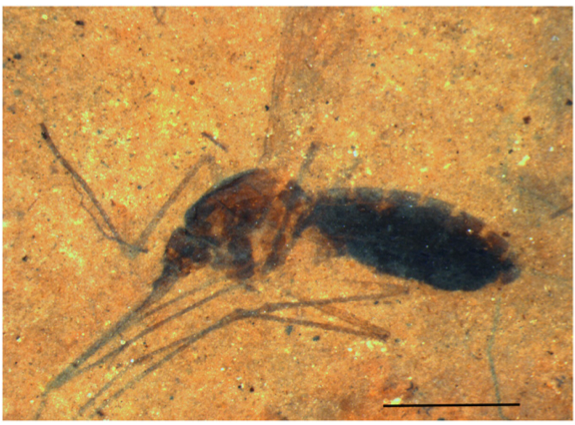“it is not surprising that a fossil of a blood-engorged mosquito has not been described [before]; this despite the popular misconception of dinosaur DNA recovery from blood-engorged mosquitoes in amber popularized by the 1993 movie Jurassic Park.” – Dale Greenwalt, paleontologist with the Smithsonian.
![The mosquito preserved in amber in the movie Jurassic Park [PHOTO: dailymail.co.uk]](https://historythings.com/wp-content/uploads/2016/09/article-2381433-19B35E7D000005DC-276_634x470.jpg)
The mosquito preserved in amber in the movie Jurassic Park (1993) [PHOTO: dailymail.co.uk]
It was probably the most improbable series of events imaginable – a scenario literally out of popular science fiction – an ancient mosquito fed on some equally ancient animals, died, was trapped in sediment, and fossilized…all without destroying the remnants of its last meal contained inside its delicate abdomen.
This is not the first instance of blood consumption – or hematophagy – in the fossil record. However, according to Dale Greenwalt, a paleontologist with the Smithsonian and lead researcher on the study, this is the first instance of hematophagy that contains traces of blood that are completely indisputable. It’s remarkable, really, like something straight out of Jurassic Park.
This is an incredibly rare find. Not only does only half the species of mosquito (the females) actually consume blood, but mosquitoes don’t live in ideal delicate-fossil-creating situations. Most fossils of blood-sucking insects come from midges, a biting fly. These are trapped in amber. Amber comes from tree sap. Unfortunately, mosquitoes usually live in open environments near lots of bodies of water, rather than sap-filled forests, preserved ancient mosquitoes are valuable and hard to find.So, can we re-create dinosaurs and start our very own Jurassic Park, now?
Well, unfortunately, DNA molecules are too delicate and complex to survive fossilization, according to Greenwalt. Not only that, but the mosquito doesn’t date early enough. It dates just to the Middle Eocene, 19 million years after dinosaurs were wiped out.
Sadly, our dreams of a park full of dinosaurs have been crushed. However, it’s worth noting that even without the possibility of growing dinosaurs in a lab, this mosquito is an immense find.
In order to give us a picture of just how crazy this find was, Dale Greenwalt explained, “The insect had to take a blood meal, be blown to the water’s surface, and sink to the bottom of a pond or similar lacustrine [lake-like] structure to be quickly embedded in fine anaerobic sediment…all without disruption of its fragile distended blood-filled abdomen.”
No dinosaurs, but an incredible discovery nonetheless.


